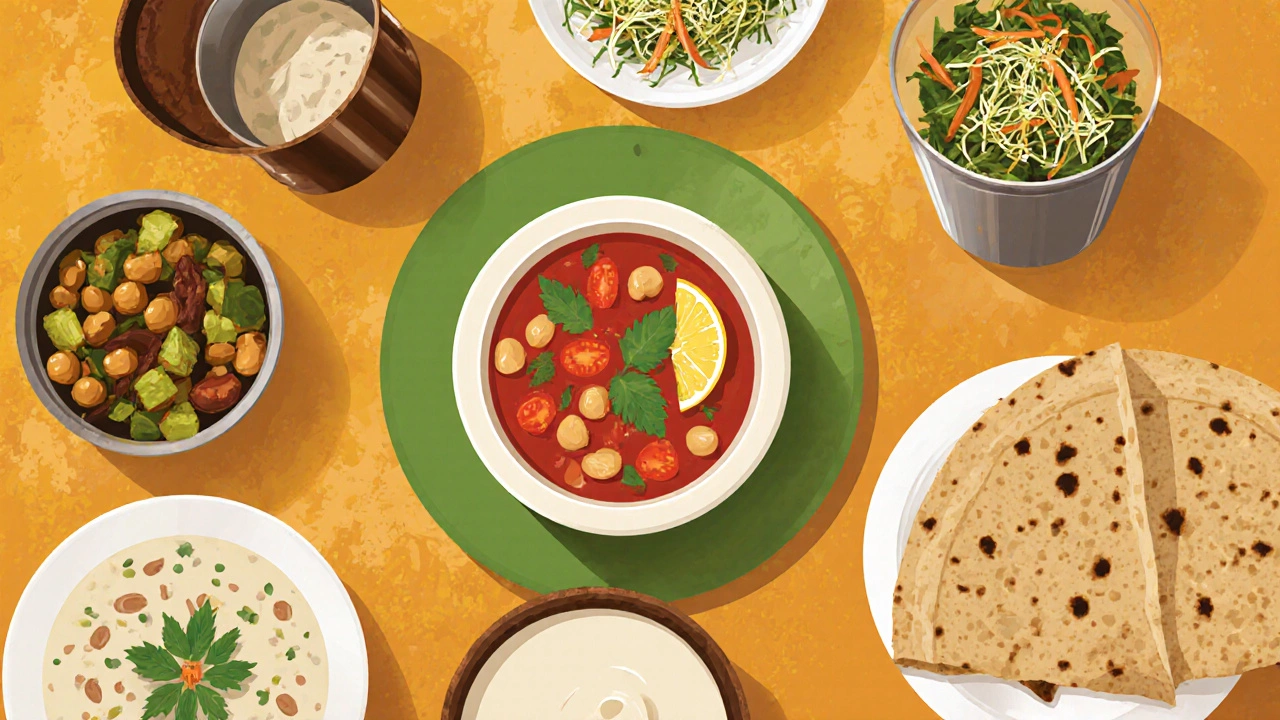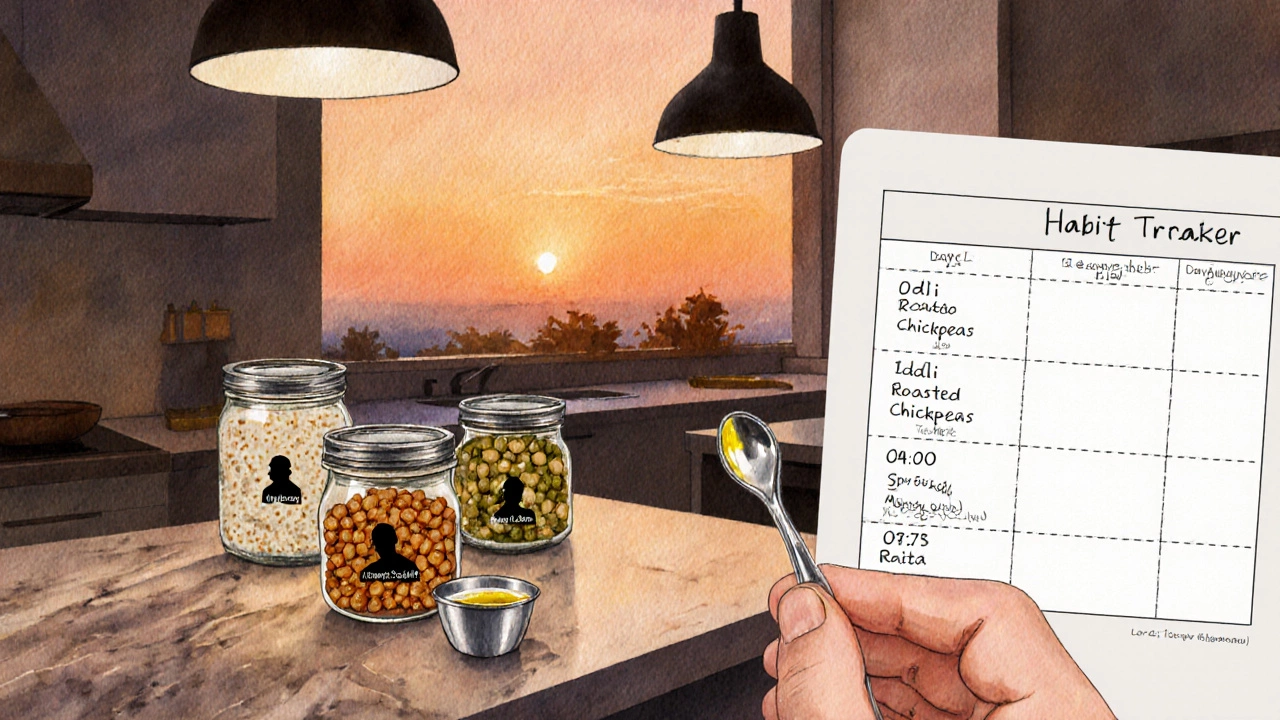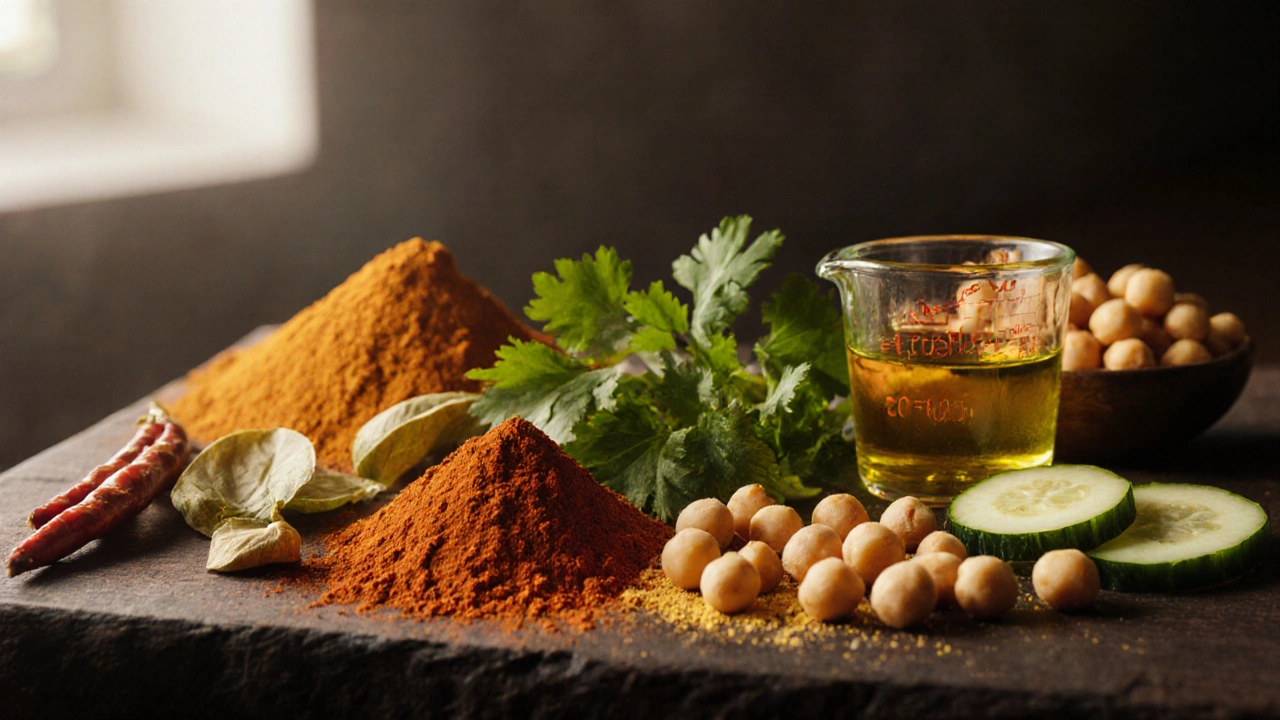Low-Calorie Indian Snack Calculator
Your Daily Calorie Goal
Select Your Snacks
Choose snacks that stay under 150 kcal per serving
Chana Chaat
120 kcal per ½ cup
Methi Thepla
130 kcal per 2-inch piece
Sprouted Moong Salad
90 kcal per cup
Idli (2 pieces)
70 kcal
Murmura Bhel
110 kcal per cup
Roasted Chickpeas
130 kcal per ¼ cup
Karela Stir-Fry
80 kcal per cup
Cabbage Poriyal
70 kcal per cup
Curd Raita
60 kcal per half-cup
Masala Oats
140 kcal per cup
Your Selected Snacks
Calories used: 0 kcal out of 0 kcal
Your Snack Plan
Smart Snacking Tips
Based on your selections:
Choose snacks that provide protein and fiber for lasting satisfaction.
Pair low-calorie snacks with a protein source like low-fat paneer or roasted nuts.
When cravings hit, you don’t have to ditch Indian flavors just to stay slim. Low‑Calorie Indian Food is a category of dishes that deliver bold spices, satisfying textures, and under 150 kcal per serving. In this guide we’ll show you how to spot those guilt‑free options, give you a ready‑to‑cook list of ten snack‑size wonders, and hand over practical tips to keep your snack stash light without sacrificing taste.
How to Identify a Low‑Calorie Indian Dish
Indian cooking is famous for oil‑heavy gravies, but many traditional snacks rely on steaming, roasting, or simple tempering. Look for these three signals:
- Cooking method: Steamed (idli, dhokla), roasted (chickpeas, peanuts), or boiled (sprouted legumes) usually stay below 150 kcal per 100 g.
- Primary ingredients: Fresh vegetables, lentils, and low‑fat dairy add volume without many calories. Avoid deep‑fried gram flour batters or excess ghee.
- Portion size: Snacks are often served in small bowls. A handful of roasted chickpeas (≈30 g) is enough to curb hunger.
When you read a recipe, ask: “Can I swap the frying step for grilling? Can I reduce the oil to a teaspoon?” Small tweaks can shave 40-60 kcal off a dish.
Top 10 Low‑Calorie Indian Snacks
Below are ten crowd‑pleasers that stay under 150 kcal per typical serving. Each entry includes the main calorie count, a quick prep note, and a tiny serving idea.
- Chana Chaat - 120 kcal per ½ cup. Toss boiled chickpeas with diced tomato, onion, coriander, lemon, and a pinch of chaat masala. No oil needed.
- Methi Thepla (fenugreek flatbread) - 130 kcal per 2‑inch piece. Made with whole‑wheat flour, fresh methi leaves, and just a teaspoon of oil.
- Sprouted Moong Salad - 90 kcal per cup. Mix sprouted green gram with cucumber, carrot, mustard seeds, and a splash of lemon.
- Idli - 70 kcal per 2‑piece set. Steamed rice‑and‑urad batter; serve with coconut chutney (keep chutney thin).
- Murmura Bhel (puffed‑rice mix) - 110 kcal per cup. Toss puffed rice with roasted peanuts, chopped veggies, and a dash of tamarind‑date chutney.
- Roasted Chickpea Snack - 130 kcal per ¼ cup. Roast canned chickpeas with paprika, cumin, and a drizzle of olive oil.
- Karela Stir‑Fry (bitter gourd) - 80 kcal per cup. Thin‑sliced karela sautéed in a non‑stick pan with mustard seeds and a pinch of salt.
- Cabbage Poriyal - 70 kcal per cup. Shredded cabbage cooked with mustard seeds, urad dal, and a few curry leaves.
- Curd Raita - 60 kcal per half‑cup. Whisk low‑fat yogurt with cucumber, mint, and a pinch of roasted cumin powder.
- Masala Oats - 140 kcal per cup. Cook rolled oats with veggies, mustard seeds, and a splash of soy sauce for a savory bite.
Comparison Table: Calories, Prep Time, and Core Nutrients
| Snack | Calories (per serving) | Prep / Cook Time | Key Nutrient |
|---|---|---|---|
| Chana Chaat | 120 kcal | 10 min | Protein ≈ 6 g |
| Methi Thepla | 130 kcal | 20 min | Fiber ≈ 3 g |
| Sprouted Moong Salad | 90 kcal | 15 min | Vitamin C ≈ 20 mg |
| Idli (2 pcs) | 70 kcal | 30 min (steam) | Carbs ≈ 14 g |
| Murmura Bhel | 110 kcal | 10 min | Fiber ≈ 2 g |
| Roasted Chickpeas | 130 kcal | 15 min (roast) | Protein ≈ 7 g |
| Karela Stir‑Fry | 80 kcal | 12 min | Iron ≈ 1 mg |
| Cabbage Poriyal | 70 kcal | 10 min | Vitamin K ≈ 45 µg |
| Curd Raita | 60 kcal | 5 min | Calcium ≈ 150 mg |
| Masala Oats | 140 kcal | 12 min | Fiber ≈ 4 g |

Quick Tips to Keep Your Snacks Light
Even a low‑calorie snack can balloon if you add hidden fats. Follow these habits:
- Measure oil with a teaspoon. A quick splash looks generous but adds 40 kcal.
- Swap regular potatoes for cauliflower or zucchini in fritters - the volume stays the same, calories drop.
- Use non‑stick cookware or a pressure‑cooker for steaming; no need for extra butter.
- Prefer fresh lemon juice or yogurt‑based sauces over cream‑heavy gravies.
- Snack from a pre‑portioned container. It’s easy to lose track when the bowl is endless.
Common Pitfalls and How to Avoid Them
Many people think “Indian = heavy”, then over‑compensate with tiny portions that don’t satisfy hunger. Here’s what to watch:
- Over‑spicing without protein: Spices are low in calories, but a snack without protein can leave you hungry soon after. Pair chaat with a spoonful of low‑fat paneer or roasted nuts.
- Hidden sugars in chutneys: Tamarind paste or date‑sweetened sauces can add 30‑40 kcal per tablespoon. Use fresh coriander‑mint chutney instead.
- Re‑frying leftovers: If you bake samosas, resist the urge to fry the next day. Re‑heat in an oven to keep the crunch.

Meal‑Planning with Low‑Calorie Snacks
Integrate these snacks into a balanced day. Example schedule for a 2000‑kcal diet:
- 08:00 am - A bowl of Idli with light coconut chutney (≈ 150 kcal).
- 10:30 am - Handful of Roasted Chickpeas (≈ 130 kcal).
- 01:00 pm - Main meal (dal, brown rice, veg).
- 04:00 pm - Sprouted Moong Salad (≈ 90 kcal).
- 07:30 pm - Light dinner, then a side of Curd Raita (≈ 60 kcal) if you still feel hungry.
Notice the snack calories stay under 150 kcal each, leaving plenty of room for protein and complex carbs at main meals.
Frequently Asked Questions
Can deep‑fried Indian snacks ever be low‑calorie?
Only if you dramatically cut the oil and keep the serving tiny. A 30‑g portion of air‑fried samosa can sit around 120 kcal, but regular frying adds 200‑300 kcal per piece, making it unsuitable for a low‑calorie plan.
Are lentil‑based snacks always low in fat?
Lentils themselves are low‑fat, but the cooking method matters. Steamed dal dhokla or boiled moong sprouts stay lean, while deep‑fried pakoras add significant fat.
How many calories should a typical Indian snack contain?
Aim for 100‑150 kcal per portion. This range satisfies cravings, supplies some protein or fiber, and won’t spike your daily total.
Can I use ghee in low‑calorie recipes?
A teaspoon of ghee (≈ 45 kcal) is acceptable if you measure it. It adds authentic flavor to thepla or poriyal without blowing the budget.
Is it okay to eat these snacks every day?
Yes, as long as you balance them with protein‑rich meals and keep total daily calories in line with your goals. Variety also ensures you get a broader nutrient mix.
